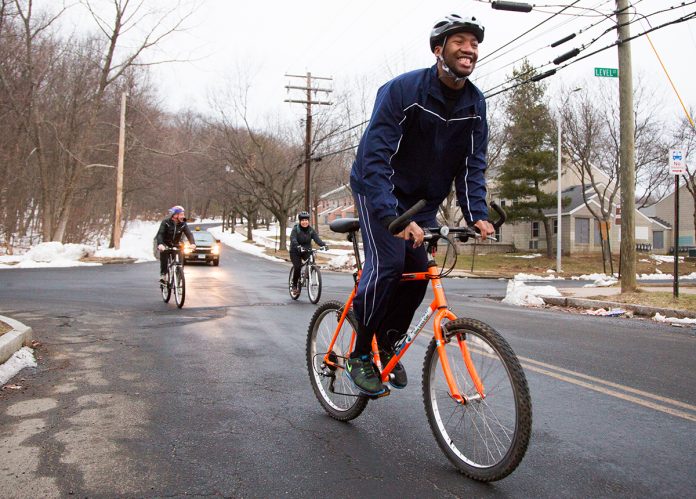Staying fit and eating healthy is always a challenge around the holiday season, but even more so with the resurgence of COVID-19 during the winter months. Kristie Rupp, assistant professor of health and movement sciences, and co-coordinator of Southern’s new master’s program in Physical Activity and Chronic Disease, offers advice about how to keep more physically active during the coming months.

1. Physical activity is an important part of improving health. What restrictions are keeping people from being more physically fit/active? What can be done about it?
For the most part, there are not really any restrictions that should prevent individuals from participating in physical activity. In terms of risk of spread of COVID-19, the lowest risk places to be physically active are outdoors and inside your own home. Now that gyms and other fitness facilities are open for the most part, it depends on your level of comfort and assessment of your own risk as to whether you feel comfortable going. If you are exercising in close proximity to others, masks are a great way to reduce the risk of transmission, in addition to being fully vaccinated and boosted, to reduce risk of spread. Ultimately, there is no one-size-fits-all answer, but incorporating physical activity into your day is essential to promote overall health and well-being.
2. The COVID pandemic has hit our state and country hard. How would a more fit or active population have affected the risk for severe illness or death from the virus?
The pandemic has had devastating consequences to the U.S. population and across the world. Certainly, a contributing factor to the devastating effects of COVID-19, particularly in the U.S. population, is the high prevalence of obesity. Approximately 40 percent of the U.S. population has obesity, which is defined as a body mass index (BMI) of ≥30kg/m2. Obesity is a significant risk factor for severe disease and death among adults <65 years. A recent large-scale epidemiological study by Robert Sallis and colleagues found that individuals who were consistently inactive (i.e. <10 minutes of moderate to vigorous physical activity per week) were 73 percent more likely to be admitted to the ICU and 2.5x more likely to die from COVID-19 in comparison to individuals who consistently met the physical activity guidelines of 150 minutes/week independent of weight status. What does this all mean? It means that regardless of body weight, incorporating even small amounts of physical activity into your day may help reduce risk of severe disease and death.
3. Discuss health care / physical activity disparities across different populations.
There is no question the inequities in health care contributed to the disparate effects of the COVID-19 pandemic, particularly in communities of color. These long-standing health care inequities affect not just the short-term COVID-19 outcomes, but also contributes to lack of routine medical care, which is needed to manage individual health and management of chronic diseases, which also disproportionately affect communities of color. Additionally, in communities with inequities in health care, there also tend to be disparities in the built environment, which present additional challenges to being physically active — for example, lack of access to safe outdoor spaces (e.g., parks), lack of sidewalks, and lack of affordable recreational facilities. Clearly, there is a demonstrable need to invest in communities disproportionately affected by the COVID-19 pandemic to improve access to routine and urgent health care and to build infrastructure that supports physical activity.
4. What are some good motivational techniques to get physically active?
Find something you enjoy! We focus on finding physical activities that kids enjoy, but it’s equally as important for adults! If you enjoy doing something, you are going to be more likely to do it. It may also help to enlist a friend or family member, so you can support one another in being more physically active. For example, something as simple as taking a walk with a friend is a great fun way to build in more physical activity. It is also very helpful to start with small, realistic goals that you know you can achieve. If you’re currently not getting in any physical activity, maybe taking a 10-minute walk twice a week is a great starting point. Remember, any activity is better than none. The greatest reduction in risk for all-cause mortality comes from going from zero minutes to 60 minutes/week of moderate physical activity, which is the equivalent of a brisk walk.
5. What role does mental health play when it comes to ensuring a plan for physical health? How can physical activity in turn impact your mental health?
Physical activity is not just beneficial for your physical health, but also improves mental health. Physical activity can help reduce depressive symptoms and symptoms of anxiety, which have increased collectively as a result of the pandemic. It can be hard to be motivated to be physically active if you are feeling depressed or anxious, but starting small with a 10-minute walk may help improve your symptoms. It is important to recognize that physical activity alone may not be enough to treat individuals with depression and/or anxiety. If you’re experiencing depression or anxiety, reach out to a qualified mental health professional to ensure you are getting the help you need. Physical activity combined with care from a mental health professional may provide the greatest benefit to overall mental health and well-being.
6. How important is it to have good nutrition, even when you’re working out regularly? And is there such a thing as too much physical activity?
Good nutrition is essential to promoting overall health and well-being. Strategies such as increasing fruit and vegetable consumption, choosing lean proteins, choosing whole wheat and whole grains, and reducing sugary beverage consumption are all great strategies to improve overall dietary quality. Improving dietary quality in addition to increasing physical activity has additive benefits to overall health. There is a dose-response relationship between physical activity and all-cause mortality, meaning the more physical activity you participate in, the greater the improvements in your health. For the general population, too much physical activity is not something to be concerned about; rather, lack of physical activity is the greater concern.
7. During the holiday season, there are lots of opportunities to stray away from healthy eating. What are some good ways to find balance? Is there one particular food we should stay away from more than others?
This is a loaded question! How much time do you have? It can be challenging to find a balance between enjoying the holidays and overindulging. It is helpful to think in advance about upcoming parties or events, where you may be more likely to indulge. Recognize, one day of overindulgence is likely not going to result in significant weight gain, but overindulging every day over the holidays probably will. It is helpful to set realistic goals for yourself over the holidays. For example, limiting your portion of dessert to one piece of pie (or half pieces of your two favorites!) at holiday gatherings, skipping the leftovers, listening to your hunger and satiety cues, and of course, increasing or maintaining your physical activity. It is important to recognize that there is no one food that should be on anyone’s banned list. If you look forward to your mom’s apple pie every year — don’t deprive yourself of that joy! Rather, setting realistic goals to manage your portion sizes is one helpful strategy to find balance.
8. Often, people get motivated and make New Year’s health resolutions that they ultimately can’t keep. What are some tips for making health resolutions you can stand by?
This is a great question. I think the biggest challenge people face in maintaining New Year’s resolutions in general is making resolutions that are not feasible in the long term. You can do anything for a short period of time, but if you are looking to make health resolutions that are sustainable, it is important to be realistic and true to yourself. For example, if you’re not currently physically active and make a resolution to join a gym and go 5x/week, this likely is not a realistic or sustainable goal. Ultimately, if you are not able to keep up your original resolution, it can be discouraging, and you may be more likely to give up on that resolution entirely. Rather, choose health resolutions that you truly value and you know will be achievable. For example, setting a goal of getting at least 10 minutes of physical activity 2 days/week may be a more appropriate and realistic goal for someone who is not currently active. You can always increase that goal as time goes on and you become more confident in your ability to be physically active, but setting an unachievable goal can ultimately be discouraging rather than helpful.
9. How will your new major assist in improving physical activity/health?
The new fully online M.S. degree in Physical Activity and Chronic Disease is an interdisciplinary degree program with coursework in the Departments of Health and Movement Sciences and Public Health. Increasingly, there is a need for practitioners who are trained in physical activity promotion and programming for individuals and communities, to improve current physical activity levels. It is estimated that 6-10 percent of deaths globally from non-communicable diseases can be attributed to physical inactivity. With increasing investment in physical activity promotion and programming from many foundations, communities, and federal agencies, graduates of this program will be uniquely qualified to fill these essential roles.
10. In closing, what’s the single most important thing a person can do to improve their health right now?
There is certainly no one-size-fits-all answer to this question. In general, to get started, take a step back, evaluate your current health behaviors, and identify one behavior that you would like to improve. Once you’ve identified that health behavior, whether it be smoking, physical activity, or nutritional quality, set yourself a realistic and achievable goal to improve that behavior. It’s important to recognize that any improvement to your health behaviors from where they are now will likely result in improvements to your overall health. Also, remember to be kind to yourself — nobody is perfect! If you slip in meeting your health behavior goals, that is okay and more than likely going to happen at some point. Rather than giving up, forgive yourself, and get back to it the next time you can.


